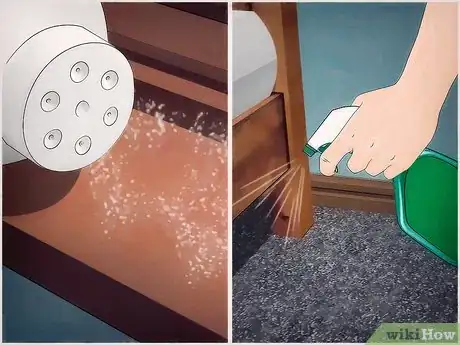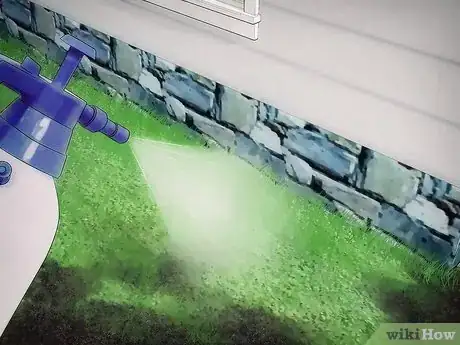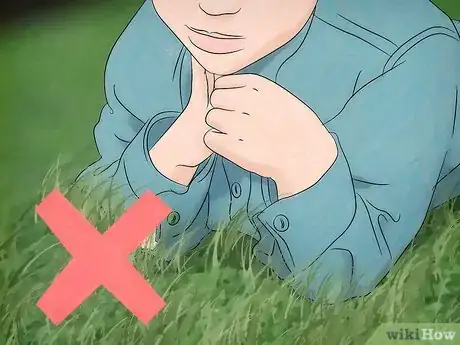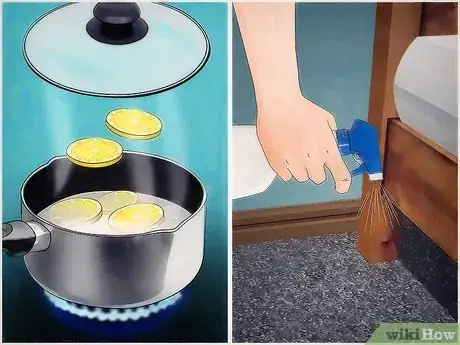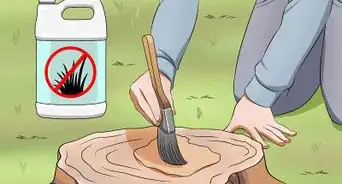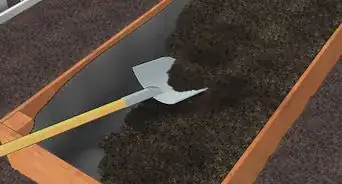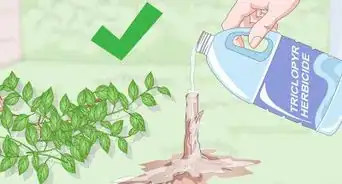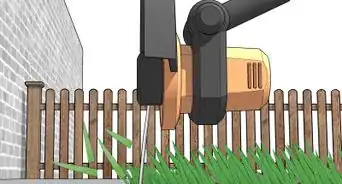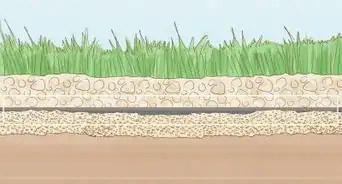This article was co-authored by Lauren Kurtz. Lauren Kurtz is a Naturalist and Horticultural Specialist. Lauren has worked for Aurora, Colorado managing the Water-Wise Garden at Aurora Municipal Center for the Water Conservation Department. She earned a BA in Environmental and Sustainability Studies from Western Michigan University in 2014.
wikiHow marks an article as reader-approved once it receives enough positive feedback. This article received 25 testimonials and 80% of readers who voted found it helpful, earning it our reader-approved status.
This article has been viewed 1,669,217 times.
Ticks in your garden and around your home can be a nuisance. Ticks can carry numerous harmful blood-borne diseases such as Lyme Disease and some diseases transferred from ticks can be deadly. This guide explains how to get rid of as many ticks as possible from around your house.
Steps
Removing Ticks Indoors
-
1De-clutter your home. Although ticks are found outdoors, indoor infestations of the brown dog tick are not uncommon. This kind of tick feeds on dogs and other animals and prefers warm, dry conditions.
- The first step in removing these ticks is to de-clutter your home, because ticks hide almost anywhere. Pick up items from the floor, and don't leave dirty laundry lying around. Your tick infestation is an opportunity to do a little spring-cleaning.
-
2Wash dirty clothes in hot water. Ticks attach to dirty clothing or bed linens. Wash clothes or linens you suspect may be tick-infected in the hottest water suitable for the fabric type.
- Avoid leaving dirty laundry on the floor, and if you suspect any clothes or linens might have ticks, do not put them in the laundry hamper, because this will contaminate the other clothes. Put them straight into the washing machine.
Advertisement -
3Clean your house thoroughly. The next step is to clean your entire home thoroughly from top to bottom. Clean out shelves, dust forgotten corners and sweep, mop, and vacuum all floors.
- Your vacuum cleaner will be your best friend during the tick-removal process, because you can suck up ticks from all over the house; in animal bedding, in cracks in the floor and wall, on baseboards and crown molding, and on and underneath furniture.
- Be sure to dispose of the vacuum bag afterwards.[1]
-
4Dust your home with pesticide. Once your house is cleaned and decluttered, and you have physically removed as many ticks as possible, you will need to use pesticides to kill any remaining ticks and their eggs.
- To kill tick eggs and larva, you need to lightly dust all areas of your home with a pesticide contain boric acid and botanical extracts. Sprinkle a little extra dust around your pet's bedding, which is a favorite laying spot.
- To kill the adults, use a pyrethrin-based pesticide spray designed especially for getting rid of brown dog ticks. This is safe for humans and pets and works quickly.
- Spray this pesticide all over the home. Don't forget carpets and curtains, and the underside of tables, chairs and sofas. Make sure to read the label for exact directions.
- Read the directions on the pesticide to see if people and animals have to leave the area for a certain amount of time after the pesticide is used.
-
5Treat indoor pets. Indoor pets, usually dogs, are the number one source of tick infestations. Dogs can carry ticks in from outdoors, or catch them from other animals in the kennel or the local neighborhood.
- First you need to physically remove any ticks that are using your animal as a host, then treat the dog with a topical tick-killing product containing ingredients such as fipronil, amitraz or permethrin. Ask your veterinarian for suggestions.
- You may also invest in a tick-repelling collar for your pet. These will keep ticks from latching onto your cat or dog for approximately three months. These collars can be difficult to find in stores, so ask your vet, or shop online.[2]
-
6Call an exterminator. Severe tick infestations may require a professional exterminator. They have specialized equipment and pesticides, which kill ticks immediately on contact. They also have an in depth knowledge of ticks' habitats and behaviors, so they will be able to locate the ticks very quickly.
- If your tick infestation remains a problem, despite your best efforts to get rid of them, you may want to consider this option.
Removing Ticks Outdoors
-
1Target the ticks' favorite habitations. Outdoor ticks can usually be found in grassy, bushy areas sheltered by trees and shade. They like high humidity.
- They can also be found in the same places favored by one of the tick's favorite meals––deer. So any time you're out in tall grasses, or hiking in the woods, you're in enemy territory.
- The first thing to do is discourage ticks from taking up residence in your home territory, by targeting any favorable tick conditions in your own backyard.
-
2Cut back vegetation. An important step in keeping ticks away is to get rid of any tick-friendly foliage. The best way to do this is keep your yard trimmed regularly and to remove all dead, scraggly, overgrown vegetation.
- Avoid grass to overgrow, and remove vines and other plants that tend to create bushy, clumped or grass-like environments.
- Moreover, since ticks are like vampires—they drink blood––and they hate the sun. Use that as your guide when removing plants, so let the sun into as many parts of your yard as possible.
-
3Mow the grass frequently. Regular mowing deprives ticks of tall grass, and lets the sun in—–this not only keeps the bugs at bay, it also evaporates morning dew quickly, depriving ticks of water, too.
- Clear tall grasses from around your house and lawn. Use an edger to create a barren zone that ticks loathe to cross on their own. They'll have to hitch a ride on a passing deer and hopefully you're keeping them out of your yard, too.
-
4Clear your yard of brush and dead leaves. If ticks cannot live in the grasses, they'll find shade elsewhere. Damp, dark brush and dead leaves—–especially dead leaves—–are tick heaven. Don't allow piles of vegetation to build anywhere in your yard.
-
5Use a pesticide. Use approved, known safe pesticides in late spring to early summer, to prevent ticks from populating your lawn. A single treatment of your yard in late May or early June can reduce tick population by over 50 percent.
- Be sure to only use pesticides approved for use in your area against ticks, and use them according to the label.
- Some good ones pesticides contain lambda-cyhalothrin and Esfenvalerate.
Preventing Ticks
-
1Fence your yard. Fencing your yard will prevent larger animals, such as deer or coyotes, from passing through your backyard. Ticks travel on mammals, so keeping larger animals out will help control the tick population in your yard. Besides, deer will chomp on your garden, and coyotes will chomp on your cats.
-
2Keep firewood stacked neatly and in a dry location. Like brush and dead leaves, firewood holds darkness and moisture. Keeping it stacked in a dry location denies ticks of their safe haven, and it will keep your firewood nice and dry when it's time to use it next winter!
-
3Don't let kids play in known tick areas. Make sure they play in areas that are located well away from high grasses or trees. If the swing set has grass growing around the legs of the set, get that weed whacker over there and start trimming!
-
4Clean thoroughly underneath bird feeders. Ticks can nest under feeders undisturbed––by cleaning regularly you make it undesirable for them.
-
5Check yourself for ticks. Regularly check yourself, your children and pets, especially after playing or hiking outdoors.
- Look for ticks in the hairline, under arms, on legs—–all over. Remove them with a pair of tweezers.
- Be careful not to squeeze the body of an embedded tick, you do not want the tick to regurgitate into the attach point as this aids in the passing of diseases such as Lyme disease.
-
6Make a natural tick repellent. You can make a non-toxic tick repellent at home. Get a 16-ounce (475ml) spray bottle and start spraying!
- Create a citrus based repellant. Ticks avoid citrus, which makes it an effective weapon. To make: Boil 2 cups of water, and add two chopped lemons, limes, oranges, or grapefruit—–alone or in combination. Let it boil for a minute or so, then simmer the concoction for an hour. Strain the fruit out, let it cool, pour into the sprayer, and squirt it on you, your kids, your pets and your yard—–anywhere ticks might like to go.
- Other natural repellents use geranium, lavender, or peppermint essential oils. These are not safe for cats though, so avoid spraying the cat or indoor areas where the cat lives.
Expert Q&A
-
QuestionWhere can I buy boric acid and botanical dust to use in my house?
 Lauren KurtzLauren Kurtz is a Naturalist and Horticultural Specialist. Lauren has worked for Aurora, Colorado managing the Water-Wise Garden at Aurora Municipal Center for the Water Conservation Department. She earned a BA in Environmental and Sustainability Studies from Western Michigan University in 2014.
Lauren KurtzLauren Kurtz is a Naturalist and Horticultural Specialist. Lauren has worked for Aurora, Colorado managing the Water-Wise Garden at Aurora Municipal Center for the Water Conservation Department. She earned a BA in Environmental and Sustainability Studies from Western Michigan University in 2014.
Professional Gardener You should be able to find boric acid and botanical dust at most garden centers, box stores, and farm supply stores.
You should be able to find boric acid and botanical dust at most garden centers, box stores, and farm supply stores. -
QuestionIn which kind of environment are ticks usually found?
 Lauren KurtzLauren Kurtz is a Naturalist and Horticultural Specialist. Lauren has worked for Aurora, Colorado managing the Water-Wise Garden at Aurora Municipal Center for the Water Conservation Department. She earned a BA in Environmental and Sustainability Studies from Western Michigan University in 2014.
Lauren KurtzLauren Kurtz is a Naturalist and Horticultural Specialist. Lauren has worked for Aurora, Colorado managing the Water-Wise Garden at Aurora Municipal Center for the Water Conservation Department. She earned a BA in Environmental and Sustainability Studies from Western Michigan University in 2014.
Professional Gardener Ticks are typically found in wet, humid environments that are shaded from the sun.
Ticks are typically found in wet, humid environments that are shaded from the sun. -
QuestionHow can ticks be killed in an instant?
 Community AnswerYou can either use a strong insecticide, a flamethrower, or a bomb.
Community AnswerYou can either use a strong insecticide, a flamethrower, or a bomb.
Things You'll Need
- Repellents
- Garden gear to cut and mow with
- Cleaning gear
- Vacuum
References
- ↑ http://www.tickencounter.org/tick_notes/tick_notes_ticks_crawling_up_walls
- ↑ http://www.popularmechanics.com/home/improvement/lawn-garden/6-simple-tips-to-get-rid-of-ticks#slide-5
- http://www.cdc.gov/lyme/ – original source
- Emax Health—Tick Removal, http://www.emaxhealth.com/8782/number-one-rule-tick-removal-lyme-disease-prevention – research source
- Emax Health—Natural Tick Repellants, http://www.emaxhealth.com/1275/fight-ticks-lyme-disease-natural-tick-repellents – research source
About This Article
Ticks are disease-carrying pests that can become a big problem during the warmer seasons. To get rid of ticks indoors, try to keep your home tidy and free of clutter so they have fewer places to hide. Keep dirty laundry off the floor and wash your clothes and bed linens in hot water to kill any ticks that might be attached to them. Sweep and vacuum your floors, furniture, and animal bedding frequently to get rid of ticks and eggs that are hiding in cracks and crevices. Once your home is clean, sprinkle your floors and furniture with a boric acid-based pesticide to kill any remaining tick eggs and larvae. You can also use a pyrethrin-based pesticide to kill adult ticks, but be careful if you have cats, since pyrethrin is toxic to them. If you have pets in the home, ask your vet to recommend an appropriate flea-killing treatment or medication. If you still can’t seem to get rid of your tick infestation, call an exterminator to treat your home. To keep ticks under control in your yard, keep your grass trimmed and rake up any dead leaves. Treat your yard with a tick-killing pesticide that’s approved in your area. Typically, the best time to use one of these treatments is in late May or early June, when outdoor tick populations start to rise. For advice from our Horticulturist reviewer on getting ticks off your dog and keeping them out of your yard, keep reading!



